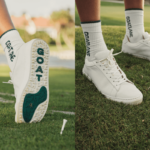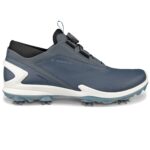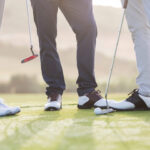To stop golf shoes rubbing, ensure they fit correctly and wear moisture-wicking socks. Apply blister prevention products for added comfort.
Golf shoes rubbing can ruin your game and cause discomfort. Properly fitting shoes are essential to avoid friction and blisters. Choose the right size and width to ensure a snug fit without tightness. Moisture-wicking socks help keep your feet dry, reducing the chance of rubbing.
Specialized blister prevention products, like moleskin or anti-friction balms, can provide extra protection. Regularly check your shoes for wear and replace them as needed. By addressing these factors, you can enjoy a more comfortable golfing experience and focus on your performance.

Credit: www.schuhe-lueke.com
Common Causes
Golf shoes rubbing can ruin your game. Understanding the common causes helps you find solutions. Here are the main reasons why your golf shoes might be causing discomfort.
Poor Fit
If your golf shoes are too tight or too loose, they will rub. Poor fit often results in blisters. Make sure to measure your feet before buying new shoes. Use a reliable size chart to find the best fit.
Here is a quick tip: wear the same socks you will use on the course when trying on shoes. This ensures a more accurate fit.
Material Issues
The material of your golf shoes plays a big role. Synthetic materials can sometimes cause more friction. Leather shoes, on the other hand, often mold better to your feet.
Check the inside of your shoes for rough seams or edges. These can also cause rubbing. If you find any, consider using moleskin or padding to cover them.
Inadequate Cushioning
Lack of cushioning can lead to discomfort. Proper cushioning absorbs shock and reduces friction. If your shoes do not have enough padding, your feet will suffer.
Consider using insoles for added comfort. Gel insoles or memory foam can make a big difference. Replace them every few months for the best results.
| Common Cause | Solution |
|---|---|
| Poor Fit | Measure your feet and use the right size chart. |
| Material Issues | Choose leather over synthetic materials. |
| Inadequate Cushioning | Use gel or memory foam insoles. |
Choosing The Right Size
Choosing the right size golf shoes is crucial to avoid rubbing. Poorly fitting shoes can ruin your game and cause blisters. Ensuring the right fit involves several steps, including measuring your feet, trying shoes on, and considering width. Each of these steps helps in finding the perfect golf shoe size.
Measuring Your Feet
Always measure your feet before buying new golf shoes. Feet size can change over time due to various factors.
- Use a foot measuring tool to get the correct length and width.
- Measure your feet in the afternoon when they are slightly swollen.
- Record the measurements for both feet since they might differ.
Trying Shoes On
Trying shoes on is essential for a proper fit. Follow these tips:
- Wear the same socks you use for golfing.
- Stand and walk around to check comfort and fit.
- Ensure there is a thumb’s width space between your toes and the shoe’s end.
Avoid shoes that feel tight or loose. Comfort should be immediate without a break-in period.
Considering Width
Width is as important as length in choosing golf shoes.
| Foot Width | Recommended Shoe Width |
|---|---|
| Narrow | Narrow Width (N) |
| Medium | Standard Width (M) |
| Wide | Wide Width (W) |
| Extra Wide | Extra Wide (XW) |
Choose a width that matches your foot’s measurement. This ensures a snug fit without rubbing.
Breaking In New Shoes
New golf shoes can cause discomfort and blisters. Properly breaking them in is crucial. This guide will show you how to prevent rubbing and ensure a comfortable fit.
Gradual Wear
Start by wearing your new golf shoes at home. Wear them for short periods initially. Gradually increase the duration each day. This helps the shoes mold to your feet.
- Wear them for 30 minutes on the first day.
- Increase to 1 hour the next day.
- Continue increasing the time daily.
Using Shoe Stretchers
Shoe stretchers can help ease tight spots. Insert the stretchers into your shoes. Leave them in overnight for the best results. This method works well for leather shoes.
| Step | Action |
|---|---|
| 1 | Insert shoe stretcher. |
| 2 | Adjust to fit tightly. |
| 3 | Leave overnight. |
Softening Leather
Leather can be stiff and cause rubbing. Soften the leather to enhance comfort. Use leather conditioners or oils. Apply a small amount to a cloth and rub it on the shoes.
- Choose a good leather conditioner.
- Apply a small amount to a cloth.
- Rub gently on the shoe surface.
Repeat this process regularly. This keeps the leather supple and reduces rubbing.

Credit: www.schuhe-lueke.com
Using Insoles And Inserts
Golf shoes can cause rubbing and discomfort. Insoles and inserts can help. They add cushioning and reduce friction. This guide explains how to use them effectively.
Types Of Insoles
There are various types of insoles available. Each type serves a different purpose. Here are some common types:
- Gel Insoles: Provide soft and flexible cushioning.
- Foam Insoles: Offer moderate support and comfort.
- Orthotic Insoles: Designed for specific foot issues.
Choose the right type for your needs. Gel insoles are good for all-day comfort. Foam insoles offer a balance of support and softness. Orthotic insoles are best for medical conditions.
Custom Inserts
Custom inserts are made specifically for your feet. They provide a perfect fit and support. You can get them through a podiatrist or specialized stores.
Custom inserts can be expensive. But, they offer the best comfort and support. They also help with specific foot problems.
Benefits Of Cushioning
Adding cushioning to your golf shoes has many benefits:
| Benefit | Description |
|---|---|
| Reduce Rubbing: | Cushioning reduces friction between your foot and shoe. |
| Improve Comfort: | Extra padding makes walking more comfortable. |
| Prevent Blisters: | Cushioning helps prevent blisters from forming. |
Using insoles and inserts can make your golf game more enjoyable. They help your feet stay comfortable all day long.
Socks Matter
Wearing the right socks can prevent your golf shoes from rubbing. Choosing the right socks is crucial for comfort and performance on the golf course. Let’s explore the key factors.
Material Choices
The material of your socks plays a significant role in comfort. Opt for socks made from high-quality materials such as cotton, polyester, or merino wool.
| Material | Benefits |
|---|---|
| Cotton | Soft and breathable |
| Polyester | Durable and moisture-wicking |
| Merino Wool | Temperature regulating and soft |
Proper Thickness
The thickness of your socks can also affect comfort. Choose socks that are not too thick or too thin.
- Thick Socks: Provide extra cushioning, but may cause tightness.
- Thin Socks: Allow for more room but offer less padding.
- Medium Thickness: Balance between comfort and fit.
Moisture-wicking Options
Moisture-wicking socks can keep your feet dry and prevent blisters. Look for socks with moisture-wicking technology.
- Polyester: Effective at wicking moisture away.
- Merino Wool: Naturally moisture-wicking and odor-resistant.
- Blends: Combine multiple materials for optimal performance.
Investing in the right socks can make a significant difference in your golf game.
Lacing Techniques
Choosing the right lacing techniques can significantly reduce the discomfort of rubbing golf shoes. Proper lacing ensures a secure fit, preventing unnecessary movement and friction. Below are some effective techniques to keep your feet comfortable during your golf sessions.
Adjusting Tightness
Ensuring the right tightness is crucial to avoid rubbing. Too tight and it creates pressure points; too loose and it causes slippage.
- Start at the bottom: Begin lacing at the bottom eyelets, ensuring even tension.
- Gradual Tightening: Gradually tighten the laces as you move up to avoid pressure points.
- Final Adjustment: Once at the top, adjust the tension to ensure a snug fit.
Alternate Lacing Methods
Different lacing methods can help distribute pressure more evenly across the foot. Here are a few techniques:
- Loop Lacing: Creates loops for better tension control.
- Parallel Lacing: Reduces pressure on the top of the foot.
- Cross Lacing: Offers a more secure fit and prevents slippage.
Preventing Slippage
Slippage can cause rubbing and blisters. Proper lacing can help prevent this.
| Technique | Benefit |
|---|---|
| Heel Lock | Secures the heel and prevents slipping. |
| Double Knot | Ensures the laces stay tied throughout the game. |
| Tongue Padding | Adds extra comfort and reduces movement. |
By following these lacing techniques, you can enjoy a comfortable golf game free of shoe rubbing issues.
Dealing With Hot Spots
Hot spots on your feet can make golfing painful. These areas of irritation can lead to blisters and sore feet. Addressing these problems early can help you enjoy your game more. This section will cover padding solutions, blister prevention, and first aid tips.
Padding Solutions
Padding can help reduce friction and prevent hot spots. Here are some effective options:
- Moleskin: Cut to fit and apply over the hot spot.
- Gel Pads: Place inside the shoe for extra cushioning.
- Foam Inserts: Use these to fill in extra space in your shoe.
Blister Prevention
Preventing blisters is key to a comfortable game. Follow these tips:
- Wear moisture-wicking socks to keep feet dry.
- Apply foot powder to reduce sweat.
- Choose shoes that fit well to minimize movement.
- Use sports tape on areas prone to blisters.
First Aid Tips
If you do get a blister, follow these first aid steps:
| Step | Action |
|---|---|
| 1 | Clean the area with soap and water. |
| 2 | Apply an antiseptic ointment to prevent infection. |
| 3 | Cover the blister with a sterile bandage. |
| 4 | Change the bandage daily until healed. |
Following these steps can help you manage hot spots effectively.
Maintaining Your Shoes
Properly maintaining your golf shoes can prevent them from rubbing. Follow these easy steps to keep your shoes in great condition. This will make your game more comfortable and enjoyable.
Regular Cleaning
Clean your shoes after every game. Use a soft brush to remove dirt. Wipe them with a damp cloth. Dry them thoroughly before storing.
- Remove laces for a thorough clean.
- Use mild soap if needed.
- Avoid harsh chemicals.
Inspecting For Damage
Check your shoes regularly for any signs of wear. Look for cracks, tears, or worn-out soles. Early detection can prevent discomfort.
- Examine the insides for any loose threads.
- Check the stitching around the seams.
- Look at the sole for uneven wear.
Replacing Worn Parts
Replace any worn parts promptly. New insoles can provide better cushioning. Fix broken laces to ensure a snug fit.
| Part | When to Replace |
|---|---|
| Insoles | Every 6 months |
| Laces | As needed |
| Soles | When worn |
Keep these tips in mind to stop your golf shoes from rubbing.

Credit: m.youtube.com
Frequently Asked Questions
How Can I Prevent Golf Shoes From Rubbing?
To prevent rubbing, ensure your golf shoes fit well. Use anti-blister socks and apply blister prevention tape on sensitive areas. Opt for shoes with good cushioning and support.
Why Do My Golf Shoes Rub My Heels?
Golf shoes might rub your heels due to improper fit. Ensure your shoes are the correct size. Break them in gradually, and consider using heel pads for added comfort.
What Are The Best Socks To Stop Rubbing?
Anti-blister socks are designed to reduce friction. Look for seamless, moisture-wicking socks with extra padding in high-friction areas. They can significantly help prevent rubbing and blisters.
Can Insoles Help With Golf Shoe Rubbing?
Yes, insoles can provide extra cushioning and support. They can help distribute pressure evenly, reducing friction and the likelihood of rubbing. Choose insoles designed for sports or specific foot issues.
Conclusion
Eliminating golf shoe rubbing enhances your game and comfort. Prioritize proper fit, quality materials, and regular maintenance. Use insoles and socks designed for golfers. Address issues early to prevent blisters and discomfort. Follow these tips, and you’ll enjoy a more comfortable and enjoyable golfing experience.
Happy golfing!





